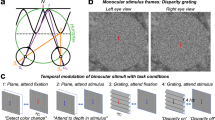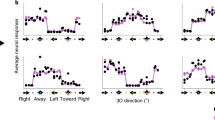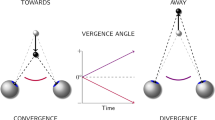Abstract
Mayhew and Longuet-Higgins have recently outlined a computational model of binocular depth perception1 in which the small vertical disparities between the two eyes' views of a three-dimensional scene are used to determine the ‘viewing parameters’ of fixation distance (d) and the angle of asymmetric convergence of the eyes (g) (refs 2, 3). The d/g hypothesis, as it has been called4, correctly predicts that a fronto-parallel surface, viewed with a vertically magnifying lens over one eye, should appear to be rotated in depth about a vertical axis1,3–5. We report here a comparable illusion for surfaces specified by monocular motion parallax information, which can be explained more simply by considering the differential invariants of the optic flow field. In addition, our observations suggest that the disparity-induced effect is not a ‘whole field’ phenomenon nor one limited to small magnification differences between the eyes1,4.
This is a preview of subscription content, access via your institution
Access options
Subscribe to this journal
Receive 51 print issues and online access
$199.00 per year
only $3.90 per issue
Buy this article
- Purchase on Springer Link
- Instant access to full article PDF
Prices may be subject to local taxes which are calculated during checkout
Similar content being viewed by others
References
Mayhew, J. E. W. & Longuet-Higgins, H. C. Nature 297, 376–379 (1982).
Longuet-Higgins, H. C. Perception 11, 377–386 (1982).
Mayhew, J. E. W. Perception 11, 387–403 (1982).
Frisby, J. Nature 307, 592–593 (1984).
Stenton, S. P., Frisby, J. P. & Mayhew, J. E. W. Nature 309, 622–623 (1984).
Ogle, K. N. Researches in Binocular Vision (Saunders, Philadelphia, 1950).
Gillam, B. & Lawergren, B. Percept. Psychophys. 24, 121–130 (1983).
Rogers, B. J. & Graham, M. E. Perception 8, 125–134 (1979).
Mayhew, J. E. W. & Frisby, J. P. Vision Res. 22, 1225–1228 (1982).
Westheimer, G. Nature 307, 632–634 (1984).
Koenderink, J. J. & van Doom, A. J. Optica Acta 22, 773–791 (1975).
Koenderink, J. J. Brain Mechanisms and Spatial Vision (eds Ingle, D., Jeannerod, M. & Lee, D.) 31–58 (Nijhof, Amsterdam, 1985).
Koenderink, J. J. Vision Res. 26, 161–179 (1986).
Longuet-Higgins, H. C. Nature 293, 133–134 (1981).
Rogers, B. J. & Graham, M. E. Vision Res. 22, 261–270 (1982).
Rogers, B. J. & Graham, M. E. Science 221, 1409–1411 (1983).
Koenderink, J. J. & van Doorn, A. J. Biol Cybernet. 21, 29–35 (1976).
Author information
Authors and Affiliations
Rights and permissions
About this article
Cite this article
Rogers, B., Koenderink, J. Monocular aniseikonia: a motion parallax analogue of the disparity-induced effect. Nature 322, 62–63 (1986). https://doi.org/10.1038/322062a0
Received:
Accepted:
Issue Date:
DOI: https://doi.org/10.1038/322062a0
This article is cited by
-
Why the eye doesn't shape up
Nature (1991)
Comments
By submitting a comment you agree to abide by our Terms and Community Guidelines. If you find something abusive or that does not comply with our terms or guidelines please flag it as inappropriate.



